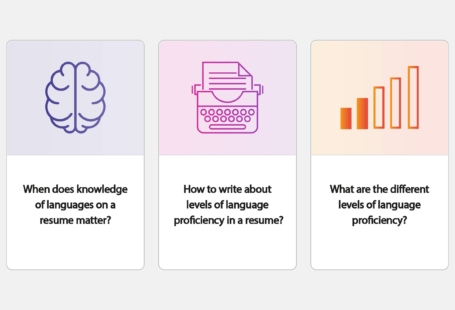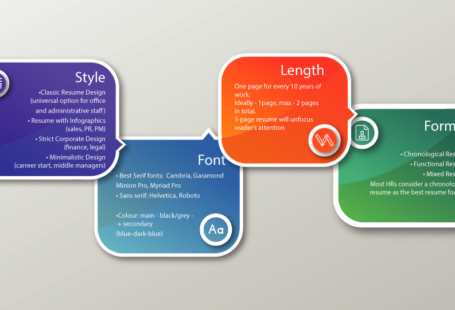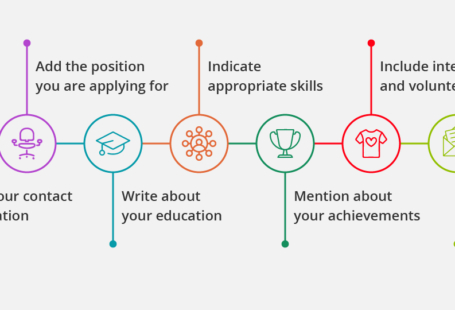The average CV gets only 8 seconds of HR executive’s eye-time. To ensure yours will blow away the competition you need a professionally designed, crisp and clear CV example with right formatting, legible fonts and just the right amount of creativity to keep that HR reading.
Naturally, you may use cv builder as a shortcut in your resume writing, anyway, let’s go from the beginning:
Here is what you will learn in this short guide:
- How to build a CV better than 9 out of 10 other.
- How to write a CV that will land you more interviews.
- How to put skills and achievements on a CV.
- How to describe your work experience on a resume to win any job you want.
Let’s go from the beginning:
Photo and Contact Information:
A professional quality photograph is essential for jobs that require presentation and people skills. Keep in mind that a good smile and a professional attire will further improve the overall positive impression. We recommended choosing a professional headshot on white or pale gray background, similar to or even better the same one you have used for your LinkedIn profile. A warm, friendly smile will make you look accessible, while crisp business attire will accentuate your professional approach. Incorporating a quality photo into your resume will help you make the right impression on your potential employer, especially if you are applying for a job in sales, human resources, public relations, event management, or a senior-level executive position.
We all know that CV needs contact information. The problem is, when you do it yourself, contact info can take up too much space and clutter up most valuable property — the top third part of a resume. Always include a phone number (with country code, even when applying locally), and a professional email address. Your location is optional unless you are considering relocation or intend to travel a lot. For instant messengers, Skype is convenient for out-of-country interviews. Always include your LinkedIn profile with a custom URL (how to get a personalised URL for LinkedIn, click here ).
Make sure you are always ready to respond to emails, phone calls or instant messages listed in your contact information section.
Summary section
Recent graduates, professionals who go for a career change, or those applying for a job outside their familiar niche should use a resume objective. If you have tons at least 2-3 positions in your chosen field then you should write a resume summary.
Depending on your career history you can post either a career objective (good for recent graduates or those changing careers) or a career summary (suitable for professionals with lots of experience in their industry).
Skills in your CV
Here you should list professional skills that perfectly match the job responsibilities listed in the job ad. This is your chance not only to list all the technical and “soft” skills you were busy developing, but also to incorporate as many keywords as you can locate in the job advertisement. This is what pleases the eye of the HR consultant and this is what ATS (recruiter’s best friend – Applicant Tracking System software) uses to sort all applications into a pile of those who made it to the HR’s close attention and those who land into that dreaded rejected pile.
Technical skills are important to list if your job requires skills in using specific tools, applications and platforms. Don’t be shy and find up to 3-5 skills.
No need to list your skill of using Microsoft Word and email — this is the same as you’d listed your skills in reading, writing, and making phone calls.
Education And Professional Development
Here you should list your education including the year and degree. In this section you should also mention your professional courses and certifications in reverse-chronological way. The more you list, the better—your willingness to embrace new technologies and learn new professional skills shows that you are a quick learner and will easily adapt in your new workplace.
Work Experience
Solid resume CV templates start with the most recent job. Be detailed about your roles and responsibilities. Use bullet points to play up project wins — how many more leads you closed, how much more profit your innovation has yielded, how many direct reports you have had. It’s important to show not only your job responsibilities but also what you have done for the company. It’s the experience you choose to share that gets you the job.
A good layout will get your resume more eye-on time and eventually will tip the scale towards your application.
What your hiring manager and eventually your future boss wants to know is, “Can you do this job?” Your experience section should answer this question.
Brainstorm all your previous jobs and extract 3-5 quantifiable achievements, even if you have to be a bit creative: “Cut production waste by 65%. Launched and completed supply room relocation project. Cut wasted foot traffic by 88% across all nursing staff.” (Now, who really counts all the footsteps made by nurses? But that’s the quantifiable achievement that draws attention.)
Remember that your experience and skills sections have to be very relevant to the job you are applying to. Carefully scan the job description and pick 8-10 keywords that are best descriptive of the job. Now, creatively plant these keywords into experience, skills, and competencies sections. They should look like they belong there, not like being crammed into the description for keyword richness sake. After all, you are ultimately aiming for human eyes, not for that merciless ATS.
Make sure it packs a punch — don’t merely list your job responsibilities but showcase your achievements in every position. Show your potential employer how much value you are going to bring to their organisation.
Languages
List any additional languages except English if you language ability is at least Intermediate. For any international company English is a prerequisite, and any subsequent language can raise your salary 10-20 percent. Some of the most sought-after (and paid well) languages include German, Spanish, French, Swedish, Turkish, and Mandarin Chinese. List any less common languages only if they are mentioned in the job ad and you believe they would add value to your resume template.
Key Competencies
This section showcases rather your professional focus and direction, as well as any “soft” skills. Here you can include any or ability you can think of, as long as it’s relevant to the current job offer. This area is most valuable for creative professional CV.
Also, in the section “About Me” steer clear from cliche words such as “responsible” or “hard-working”. Instead tell the employer what you enjoy about your job and where do you see heading to. You can mention a few personal traits that you think can highlight your professional skills. And no, playing ukulele is not one of them.
Finally, save your resume as a PDF to keep all the smart formatting in place, since Word documents can often mess up your well-thought formatting efforts. You are good to go!
Still have questions? Take a look also at our tips about How to do a CV and What to Include and What to Avoid



